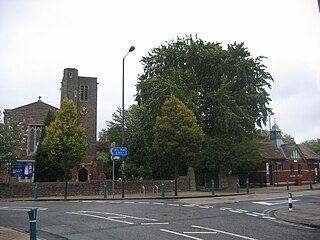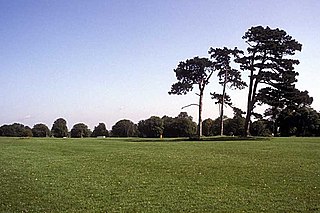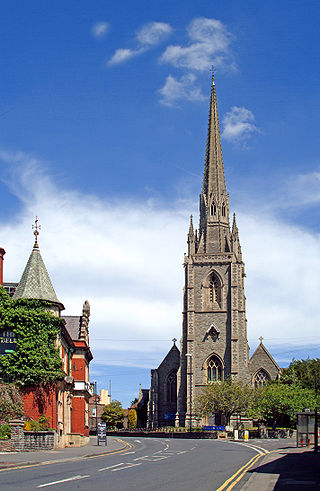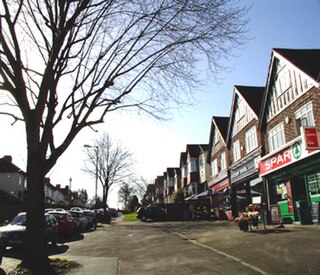
Severn Beach is a village on the Severn Estuary in South Gloucestershire, England. The eastern portal of the Severn Tunnel is on the outskirts of the village. The Severn footpath – on the sea wall – is part of the Severn Way that leads from Gloucester, Slimbridge and the Second Severn Crossing. Extensive sea defences have been constructed and this provides a popular walkway along its length. Originally, the Severn Way finished at Severn Beach, but it has been extended to Bristol.

Avonmouth is a port and outer suburb of Bristol, England, on the north bank of the mouth of the River Avon and the eastern shore of the Severn Estuary. Part of the Port of Bristol, Avonmouth Docks is important to the region's maritime economy, hosting large vessels for the unloading and exporting of heavier goods. Much of the land use is industrial, including warehousing, light industry, electrical power and sanitation. The M5 motorway bisects the neighbourhood, with junctions onto the A4 road and M49 motorway, and it has stations on the Severn Beach Line railway.

Clifton Down is an area of public open space in Bristol, England, north of the village of Clifton. With its neighbour Durdham Down to the northeast, it constitutes the large area known as The Downs, much used for leisure including walking and team sports. Clifton Down is the part of the Downs south of Stoke Road.

Durdham Down is an area of public open space in Bristol, England. With its neighbour Clifton Down to the southwest, it constitutes a 400-acre (1.6 km2) area known as The Downs, much used for leisure including walking, jogging and team sports. Its exposed position makes it particularly suitable for kite flying. Durdham Down is the part of the Downs north of Stoke Road.

The Downs are an area of public open limestone downland in Bristol, England. They consist of Durdham Down to the north and east and Clifton Down to the south, separated by Stoke Road.

Stapleton is an area in the northeastern suburbs of the city of Bristol, England. The name is colloquially used today to describe the ribbon village along Bell Hill and Park Road in the Frome Valley. It borders Eastville to the South and Begbrook and Frenchay to the North. It comprises an eclectic mix of housing mainly from the Victorian, Edwardian, inter-war and late 20th century periods.

Shirehampton is a district of Bristol in England, near Avonmouth, at the northwestern edge of the city.

The Avonmouth Docks are part of the Port of Bristol, in England. They are situated on the northern side of the mouth of the River Avon, opposite the Royal Portbury Dock on the southern side, where the river joins the Severn estuary, within Avonmouth.

Wills Hall is one of more than twenty halls of residence in the University of Bristol. It is located high on the Stoke Bishop site on the edge of the Bristol Downs, and houses c. 370 students in two quadrangles. Almost all of these students are in their first year of study.

Stoke Bishop is an outer suburban neighbourhood and an electoral ward in the north-west of Bristol, England. Bordered by The Downs and the River Trym, it is located between Westbury-on-Trym, Sneyd Park and Sea Mills. Although relatively low, Stoke Bishop's population has significantly increased in recent years due to the infilling of former school and company playing fields. Moreover, the population of Stoke Bishop varies throughout the year because of the influx of students during term time to the large campus of Bristol University halls of residence situated on the edge of The Downs.

The Boxkite was the first aircraft produced by the British and Colonial Aeroplane Company. A pusher biplane based on the successful Farman III, it was one of the first aircraft types to be built in quantity. As the type was used by Bristol for instruction purposes at their flying schools at Larkhill and Brooklands many early British aviators learned to fly in a Boxkite. Four were purchased in 1911 by the War Office and examples were sold to Russia and Australia. It continued to be used for training purposes until after the outbreak of the First World War.
Sea Mills is a suburb of Bristol, England, 3.5 miles (6 km) north-west of the city centre, between the former villages of Shirehampton, Westbury-on-Trym and Stoke Bishop, by the mouth of the River Trym where it joins the River Avon.
The city of Bristol, England, is divided into many areas, which often overlap or have non-fixed borders. These include Parliamentary constituencies, council wards and unofficial neighbourhoods. There are no civil parishes in Bristol.

Sea Mills railway station is on the Severn Beach Line and serves the districts of Sea Mills, Stoke Bishop, Sneyd Park and nearby Westbury on Trym in Bristol, England. It is 6 miles (9.7 km) from Bristol Temple Meads, situated at the confluence of the River Avon and River Trym and near the A4 Bristol Portway. Its three letter station code is SML. The station has a single platform which serves trains in both directions. As of 2015 it is managed by Great Western Railway, which is the third franchise to be responsible for the station since privatisation in 1997. They provide all train services at the station, mainly a train every 30 minutes in each direction.
The Bristol Port Railway and Pier was a railway in Bristol, England.
Halls of residence at the University of Bristol are generally located within three distinct areas of Bristol, the City Centre, Clifton and Stoke Bishop.
Sir George White, 1st Baronet (1854–1916), was an English businessman and stockbroker based in Bristol. He was instrumental in the construction of the Bristol tramways and became a pioneer in the construction of electric tramways in England. In 1910 he formed, with his brother Samuel, the Bristol Aeroplane Company. He had many other interests, particularly in transport companies.
Graham Gilmour was a British pioneer aviator, known for his impromptu public displays of flying. He was killed on 17 February 1912 when his Martin-Handasyde monoplane suffered a structural failure and crashed in the Old Deer Park in Richmond, London.

Stuart Colman was an architect based in Bristol and London, England.














